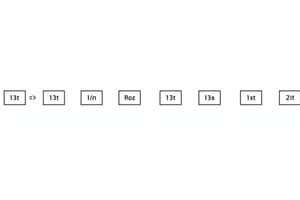Podcast
Questions and Answers
What is the priority of the task 'Job Z' in the given sample input?
What is the priority of the task 'Job Z' in the given sample input?
- 1 (correct)
- 3
- 4
- 2
What is the purpose of the 'prev' and 'next' variables in the PriorityQueueNode class?
What is the purpose of the 'prev' and 'next' variables in the PriorityQueueNode class?
- To store the data and priority of the task
- To point to the previous and next nodes in the queue (correct)
- To keep track of the number of tasks in the queue
- To determine the priority of the task
What happens when a new task with a higher priority is inserted into the queue?
What happens when a new task with a higher priority is inserted into the queue?
- It is added to the end of the queue
- It is ignored and not added to the queue
- It is inserted in the middle of the queue
- It is added to the beginning of the queue (correct)
What is the output of the given sample input?
What is the output of the given sample input?
What is the purpose of the 'insert' method in the PriorityQueue class?
What is the purpose of the 'insert' method in the PriorityQueue class?
What is the data type of the 'priority' variable in the PriorityQueueNode class?
What is the data type of the 'priority' variable in the PriorityQueueNode class?
What happens when a new task with a lower priority is inserted into the queue?
What happens when a new task with a lower priority is inserted into the queue?
What is the role of the 'head' variable in the PriorityQueue class?
What is the role of the 'head' variable in the PriorityQueue class?
What is the purpose of the PriorityQueueNode class?
What is the purpose of the PriorityQueueNode class?
What is the significance of the 'priority' attribute in the PriorityQueueNode class?
What is the significance of the 'priority' attribute in the PriorityQueueNode class?
Flashcards are hidden until you start studying
Study Notes
Priority Queue using Doubly Linked List
- A priority queue is a data structure that stores elements with associated priorities and allows efficient retrieval of the element with the highest priority.
Node Definition
- A node in the doubly linked list holds both the data and the priority.
- Each node has references to the previous and next nodes in the list.
Initialization
- Initialize an empty priority queue by setting its head and tail pointers to null.
Insertion Operation (PUSH())
- When inserting an element with a priority, create a new node with the data and priority.
- Traverse the list to find the correct position based on priority.
- Start from the head and move to the right until you find a node with a lower or equal priority.
- Insert the new node at the correct position by updating the next and previous pointers accordingly.
Deletion Operation (POP())
- To remove the highest-priority element, simply remove the node at the head of the list.
- Update the head pointer to point to the next node.
Retrieval Operation (PEEK() or TOP())
- To retrieve the highest-priority element without removing it, access the data of the node at the head of the list.
Example
- A priority queue can be used to prioritize tasks based on age, ensuring that older individuals are served or processed first.
- In a healthcare triage scenario, a priority queue can be used to prioritize elderly patients who need immediate attention.
Sample Input and Output
- Sample Input 1: Insert tasks with different priorities into the priority queue.
- Sample Output 1: The highest-priority task is retrieved and executed first, followed by tasks in order of their priorities.
Studying That Suits You
Use AI to generate personalized quizzes and flashcards to suit your learning preferences.





